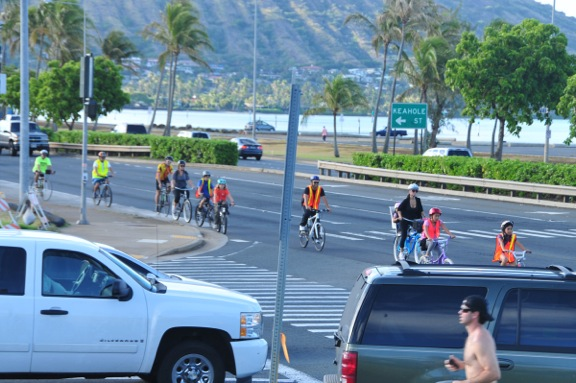Students find a safe route to school
Sixty percent of Waldorf’s student body biked, walked, scootered or skateboarded to school on Tuesday.
“Schools vital to obesity war.” “Bus cuts loom as students head for summer break.” “Report: half of schools, including Hawaii schools, fail federal standards.” “Hawaii drivers need to brace themselves for back to school traffic.”
At first glance, the problems behind these headlines appear daunting. News articles regularly report the unhealthy state of many of our residents. Year after year we read about low grades and academic performance of our students. Traffic congestion continues to get worse. One potential solution is readily available, however, if administrators and parents take an active role in making a change.
Earlier this year, the Hawaii Safe Routes to School Day Challenge was issued. That challenge directed parents, teachers and others to pick a school, pick a route (walkable or bikeable) and pick up kids along that route the fourth Wednesday of every month. The challenge culminated in a special Bike to School Day, May 15. Honolulu Waldorf School took that challenge by the horns and set an aggressive goal of 50% participation for Bike to School Day.
When that challenge came out, I doubt many people believed any school in Hawaii would have even half that amount of students using non-motorized transportation on any given day. Waldorf came through, however, and not only met that goal, but exceeded it. Sixty percent of Waldorf’s student body biked, walked, scootered or skateboarded to school on the 15th. Some parents walked or biked along with their children. In addition, Representatives Ward and Marumoto as well as Wayne Yoshioka, Director of the Department of Transportation Services (DTS), and several from his staff, joined students en route to school.
One parent remarked that there were only three cars in the school’s parking lot instead of the queue that typically extends onto the roadway, and there were ample parking stalls available on the road in front of the school. A DTS staff member is going to follow up by starting a Safe Routes to School program for a school in Kaimuki. And the children enjoyed the opportunity to get out of the car and socialize with their friends.
It’s no secret that when more people bike or walk, traffic congestion is reduced, and people who are active are generally healthier. What may be less known, however, is that physical activity is positively related to academic performance in children. Children who begin the day with physical activity are ready to learn. Other benefits for children include the opportunity to develop independence, responsibility and heightened safety skills.
A number of projects and plans are in place to encourage people to walk and bike more, but they will take years, even decades, to make a significant impact on our environment and transportation system. I invite, actually I urge, people to become involved and learn more about the Safe Routes to School program and bike or walk to school with a child—help implement a solution to some of today’s biggest concerns.
